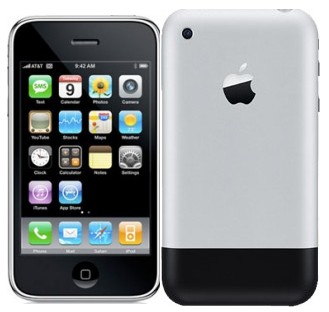I remember several years ago when I was working a summer job in Minnesota. It was 2007 and the long awaited rumors of Apple's first iPhone had become reality and in effect, the world of mobile phones changed forever. I personally experienced a mental battle which raged between the side of practicality ("You already have a working phone that is in excellent shape and so you don't need to buy a new phone") and curiosity/interest ("Look how amazing the iPhone is...look at all you can do!"). After several days of internal debating, I broke down and bought an iPhone approximately a week after it was released.
What happened? Did curiosity/interest decidedly trounce practicality? Not at all. Practicality won out in the end...and that is the secret to Apple's success with the iPhone.
Image may be NSFW.
Clik here to view. Why is this seemingly overpriced luxury item a practical purchase? Simply, the iPhone has integrated functionality: it is one device that does everything. It makes calls. It allows you to text with a QWERTY keyboard. It plays music (meaning you can leave your separate MP3 player at home). It lets you use your business and personal email accounts. It lets you search the internet. It gives you maps and directions. It tells you the time. It lets you buy music and movies on the go. It keeps track of your contacts and gives you a calendar that you can sync with your work calendar. It also provides all of this in a compact device that is rugged yet sophisticated and incredibly easy to use.
Why is this seemingly overpriced luxury item a practical purchase? Simply, the iPhone has integrated functionality: it is one device that does everything. It makes calls. It allows you to text with a QWERTY keyboard. It plays music (meaning you can leave your separate MP3 player at home). It lets you use your business and personal email accounts. It lets you search the internet. It gives you maps and directions. It tells you the time. It lets you buy music and movies on the go. It keeps track of your contacts and gives you a calendar that you can sync with your work calendar. It also provides all of this in a compact device that is rugged yet sophisticated and incredibly easy to use.
In effect, the basic functionality of the iPhone allows you to carry a phone, MP3 player, GPS, computer, day planner, and camera in your pocket. With the addition of "Apps," this functionality grows exponentially. I was surprised to find that some critics predicted the iPhone to flop because they saw all of this extra functionality as superfluous. Time has proven that having all of your tools in one place makes for a more elegant solution.
The same thing is true in the world of maintenance and reliability. Many companies today are still trying to face their challenges with solutions that resemble the pre-iPhone mobile phone industry. These companies know they need an Enterprise Asset Management system (EAM) in order to keep track of their asset data. Sometimes they use a separate root cause analysis program to figure out why their equipment fails but the results of this analysis is not tied to the asset record in the EAM system. Other companies have heard about the benefits of Reliability Centered Maintenance (RCM) and so they gather a group of engineers and operators together to do the analysis which remains in a spreadsheet or printed in a book in the manager's office. Some companies have other data sources like process historians and condition monitoring data which they cannot seem to tie to any of the other data sources and analyses.
Enter Asset Performance Management (APM) and APM software. APM is the closest thing to an "iPhone for maintenance and reliability" that you can find in the world today. Why? Because, like the iPhone, APM software has integrated functionality. As a tool, it is a "one stop shop" for asset data, allowing engineers to quickly find the information that they need. These engineers are able to see all failure history, condition monitoring data, as well as any analyses associated with any piece of equipment. APM software takes away the hassle of trying to manually combine data from different sources, allowing engineers to do real engineering work. APM software is practical for all companies who need to manage physical assets.
The edge that this "iPhone" gives to executives is manyfold. Having centralized data means that your engineers can track asset performance and catch asset failures befor they occur, ensuring that unplanned downtime does not upset production goals and revenue streams. APM software helps you to maintain regulatory compliance in areas like mechanical integrity, protecting you against excessive fines and protecting employee safety against explosions and chemical loss of containment. As history has proven multiple times, plant explosions are expensive and hurt people, profits, company reputation, and the environment. With APM software and properly applied work processes, you are protected against the many painful "surprises" that plague process industries.
For more information on how to gain this competitive edge in asset intensive industries, contact us by clicking here.